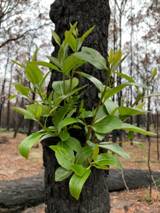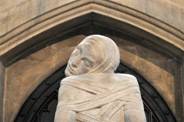| Anglican lectionary: Catholic lectionary: |
1st Reading Ez 37:1-14 both |
Psalm 130 – |
2nd Reading Rom 8:6-11 both |
Gospel John 11:1-45 both |
by The Rt Revd Dr Richard Treloar, Bishop of Gippsland, Australia
As our Lenten experience deepens, and we move into Passiontide, the readings for this fifth Sunday in the season give us a foretaste of the promise of this costly journey from death to new life.
The dis-membered bones in the valley the Lord shows to Ezekiel are ‘very dry’ – yebeyshot in the Hebrew – the same verb that is used to describe the dry ground in Genesis 1:9, a site of creation and transformation.
In the recent Australian summer we have felt the consequences of such dryness as a contributing factor to the severity and extent of the bushfires in many regions. My own diocese of Gippsland was one of those impacted. In January and February I travelled through extensive areas of forested natural habitat which was devastated by fires, as were some of the townships and farms they surround.
 Within a few days and weeks of the rain that eventually and mercifully fell, sprouts of new green growth began to push out of charred branches and blackened trunks, reminding me of the subdued Easter hymn ‘Now the green blade riseth’.
Within a few days and weeks of the rain that eventually and mercifully fell, sprouts of new green growth began to push out of charred branches and blackened trunks, reminding me of the subdued Easter hymn ‘Now the green blade riseth’.
Perhaps this is an ecological equivalent of the more anthropocentric parable Ezekiel narrates of the animation of those dry bones.
Lazarus is summoned by the word of Christ from death to life. With him, the whole creation is summoned to new life by the Word that is Christ, through whom all things were made.
For us, that summons is first heard and responded to in baptism where, as St Paul describes it in Romans, the pattern of Christ’s dying and living is re-membered in us, starting with the question, ‘Do you turn to Christ?’
 If you have seen Jacob Epstein’s sculpture of a still tightly bound Lazarus in the Chapel of New College, Oxford, you will no doubt have been struck by the man’s head which, despite the winding cloths of the grave, is turning towards a summons that seems to be coming from behind him in the direction of the altar and the great lectern.
If you have seen Jacob Epstein’s sculpture of a still tightly bound Lazarus in the Chapel of New College, Oxford, you will no doubt have been struck by the man’s head which, despite the winding cloths of the grave, is turning towards a summons that seems to be coming from behind him in the direction of the altar and the great lectern.
How do we respond to the Gospel summons conveyed to us in word and sacrament when faced with apparently uncontrollable forces like a bushfire or the Coronavirus? Both advance in frightening and escalating waves, leaving our often hubristic and theologically ill-derived sense of ‘dominion’ over nature in their wake along with much else, tragically.
Our shared responsibility to try and slow down the spread of the virus calls us in one sense to a social distancing or even isolation that may feel tomb-like, and indeed casts our mortality into sharp relief.
Might this strange and unchartered space also prove to be womb-like?
To what fullness of life might we be called as we emerge from the forced and abrupt removal of so many of the freedoms that we often take for granted?
What new shoots of our humanness might spring up in the spaces between us after the emergency has passed?
How might we come to appreciate the gift of a handshake, or the blessings of readily available food and basic domestic products?
How could a greater awareness of the non-essential nature of some of our travel and other activities lessen the impact on our environment of this Anthropocene age?
In the dryness of these late Lenten days, when churches may be closed, uncertainty and anxiety appear to reign, and economies shrink, may we remain a people of hope: expectantly open to Holy Spirit’s animating and re-animating breath in our world; preparing the dry yet fertile ground of our hearts for the vidi aquam of that great Easter antiphon – the water Ezekiel saw flowing from the side of the Temple (47:1) – to bubble up baptismally in us and through us from the wounded side of Christ; ready and waiting to turn again to him when summoned on Easter Day.
A suggestion for further reading:
Jonathan Cornford, Coming back to Earth: Essays on the Church, Climate Change, Cities, Agriculture and Eating (Melbourne: Morning Star Publishing; 2016).
by Bishop Dr Richard Treloar, Australia
 Erasmus+ – project
Erasmus+ – project